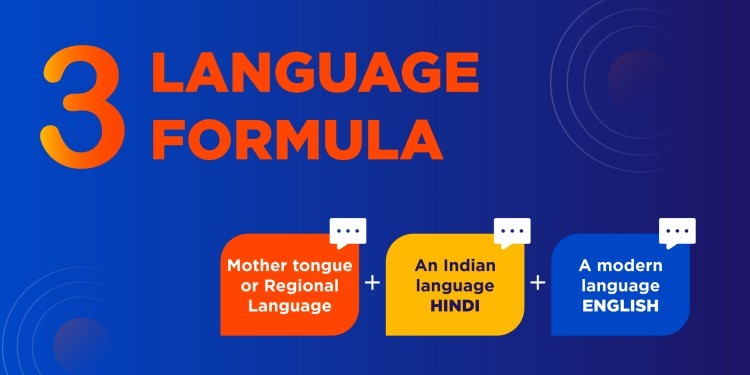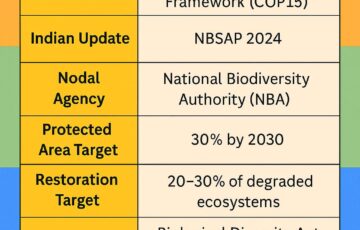Three-Language Policy: Challenges in Implementation Across India
Syllabus:
GS-2:
Education , Issues Arising Out of Design & Implementation of Policies , Issues Relating to Development
Focus:
The ongoing debate over the three-language policy in India, especially in Tamil Nadu, has highlighted gaps in language offerings across states. Recent data reveals the dominance of Hindi and Sanskrit in Hindi-speaking states and limited options for third languages in non-Hindi-speaking regions, raising concerns about linguistic diversity.
Understanding the Three-Language Policy in India:
Overview of the Policy
- The Three-Language Policy in India aims to promote multilingualism by requiring students to learn three languages:
- Hindi-speaking states: Hindi, English, and a modern Indian language (preferably from the south).
- Non-Hindi-speaking states: Hindi, English, and the regional language.
- The policy was introduced to ensure linguistic diversity and national integration.
Current Controversy and Lack of Data
- The debate on the three-language policy remains unresolved, especially in Tamil Nadu, which has consistently opposed it.
- A recent question by DMK MP Kanimozhi Karunanidhi in the Lok Sabha (LS) highlighted the absence of comprehensive data on the languages currently taught in Indian schools.
- The LS reply provided only the percentage of schools implementing the three-language formula, without specifying the languages taught.
Insights from the 2009 All India School Education Survey:
Limited and Outdated Data Availability
- The 2009 All India School Education Survey is the last comprehensive survey providing details on languages taught in schools.
- This report is not publicly accessible and was obtained by The Hindu through sources in the Education Ministry.
- Even the 2009 survey data only covers primary-stage education and lacks school-wise language details.
Language Distribution in Hindi-Speaking States (2009 Survey Data)
- In Bihar:
- 1% of schools taught Hindi
- 64% taught English
- 56% taught Sanskrit
- Only 8% offered other languages
- 1% of schools taught Hindi
- In Uttar Pradesh (UP):
- 94% taught Hindi
- 3% taught English
- 2% taught Sanskrit
- Only 7% offered other languages
- 94% taught Hindi
- In Uttarakhand:
- 5% taught Hindi
- 5% taught English
- 4% taught Sanskrit
- Only 6% offered other languages
- 5% taught Hindi
Language Trends in Non-Hindi-Speaking States (2009 Survey Data)
- In Gujarat:
- 97% of schools taught Gujarati
- 9% taught English
- 64% taught Hindi
- Only 2% offered other languages
- 97% of schools taught Gujarati
- In Karnataka:
- 5% taught Kannada
- 2% taught English
- 4% taught Hindi
- Only 15% offered other languages
- 5% taught Kannada
- In Punjab:
- 2% offered Hindi
- Less than 1% taught languages other than English and Punjabi
- 2% offered Hindi
Imbalance in Language Offerings
- The data suggests that Sanskrit is the default third language in Hindi-speaking states instead of a modern southern language, as recommended by the 1968 National Education Policy (NEP).
- In non-Hindi-speaking states, Hindi emerges as the default third language instead of a broader range of options.
Current Challenges in Implementing the Three-Language Policy:
Shortage of Language Teachers
- Himachal Pradesh’s Education Department revealed a lack of demand for languages like Telugu, Tamil, and French due to the unavailability of teachers.
- Teacher vacancy data in Himachal Pradesh:
- Punjabi teaching posts: 34% vacant
- Urdu teaching posts: 71% vacant
- Sanskrit teaching posts: Only 9.8% vacant
- Punjabi teaching posts: 34% vacant
- The high availability of Sanskrit teachers suggests it remains the preferred third language.
Limited Language Enrollment in Hindi-Speaking States
- In Uttar Pradesh, very few students opt for southern languages:
- One student registered for Malayalam
- Three students for Tamil
- Five students for Kannada
- One student registered for Malayalam
- These students often appear as private candidates.
Uneven Implementation Across States (2023-24 Data):
Disparities in Three-Language Formula Implementation
- The LS reply for 2023-24 shows low adherence to the three-language formula:
- In Bihar, Jharkhand, West Bengal, and Odisha: Less than 50% of schools have implemented the formula.
- In Himachal Pradesh, Madhya Pradesh, and Haryana: Less than 60% of schools comply.
- This indicates inefficient and inconsistent execution of the policy even in states that agreed to adopt it.
Way Forward:
Urgent Need for Updated and Comprehensive Data
- The absence of recent and detailed data hinders an accurate understanding of the three-language policy’s effectiveness.
- Updated surveys are needed to track language offerings, student choices, and teacher availability across states.
Recommendations for Effective Policy Implementation
- Strengthen teacher training and recruitment in languages with low availability.
- Promote regional and international languages to ensure multilingualism and cultural diversity.
- Conduct regular, transparent surveys and make data publicly accessible for policy refinement.
Conclusion:
The three-language policy, intended to foster multilingualism and cultural integration, faces challenges due to uneven implementation, teacher shortages, and outdated data. Effective execution requires comprehensive, updated data, teacher training, and policy adjustments to ensure inclusivity and linguistic diversity across states.
Source: TH
Mains Practice Question:
Q: The three-language policy in India aims to promote linguistic diversity and national integration. Critically analyze its implementation challenges and suggest measures for effective policy execution. (250 Words)






